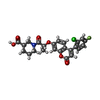+Search query
-Structure paper
| Title | Small-molecule inhibitors of human mitochondrial DNA transcription. |
|---|---|
| Journal, issue, pages | Nature, Vol. 588, Issue 7839, Page 712-716, Year 2020 |
| Publish date | Dec 16, 2020 |
 Authors Authors | Nina A Bonekamp / Bradley Peter / Hauke S Hillen / Andrea Felser / Tim Bergbrede / Axel Choidas / Moritz Horn / Anke Unger / Raffaella Di Lucrezia / Ilian Atanassov / Xinping Li / Uwe Koch / Sascha Menninger / Joanna Boros / Peter Habenberger / Patrick Giavalisco / Patrick Cramer / Martin S Denzel / Peter Nussbaumer / Bert Klebl / Maria Falkenberg / Claes M Gustafsson / Nils-Göran Larsson /    |
| PubMed Abstract | Altered expression of mitochondrial DNA (mtDNA) occurs in ageing and a range of human pathologies (for example, inborn errors of metabolism, neurodegeneration and cancer). Here we describe first-in- ...Altered expression of mitochondrial DNA (mtDNA) occurs in ageing and a range of human pathologies (for example, inborn errors of metabolism, neurodegeneration and cancer). Here we describe first-in-class specific inhibitors of mitochondrial transcription (IMTs) that target the human mitochondrial RNA polymerase (POLRMT), which is essential for biogenesis of the oxidative phosphorylation (OXPHOS) system. The IMTs efficiently impair mtDNA transcription in a reconstituted recombinant system and cause a dose-dependent inhibition of mtDNA expression and OXPHOS in cell lines. To verify the cellular target, we performed exome sequencing of mutagenized cells and identified a cluster of amino acid substitutions in POLRMT that cause resistance to IMTs. We obtained a cryo-electron microscopy (cryo-EM) structure of POLRMT bound to an IMT, which further defined the allosteric binding site near the active centre cleft of POLRMT. The growth of cancer cells and the persistence of therapy-resistant cancer stem cells has previously been reported to depend on OXPHOS, and we therefore investigated whether IMTs have anti-tumour effects. Four weeks of oral treatment with an IMT is well-tolerated in mice and does not cause OXPHOS dysfunction or toxicity in normal tissues, despite inducing a strong anti-tumour response in xenografts of human cancer cells. In summary, IMTs provide a potent and specific chemical biology tool to study the role of mtDNA expression in physiology and disease. |
 External links External links |  Nature / Nature /  PubMed:33328633 PubMed:33328633 |
| Methods | EM (single particle) |
| Resolution | 3.5 Å |
| Structure data | EMDB-11679, PDB-7a8p: |
| Chemicals |  ChemComp-R4Q: |
| Source |
|
 Keywords Keywords | TRANSCRIPTION / Mitochondria / Polymerase / Inhibitor |
 Movie
Movie Controller
Controller Structure viewers
Structure viewers About Yorodumi Papers
About Yorodumi Papers





 homo sapiens (human)
homo sapiens (human)